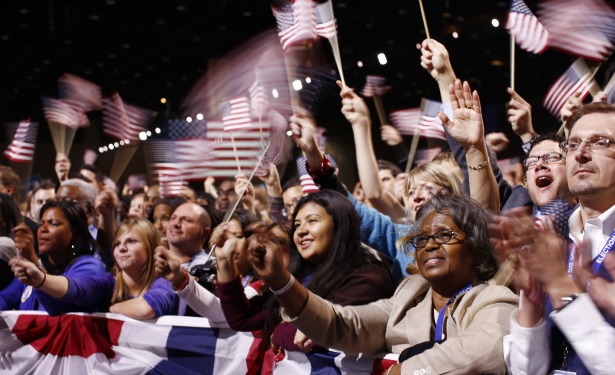The Coalition of Transformation vs. the Coalition of Restoration
How the 2012 election heralds an historical reconfiguration of American politics

This long march of a presidential election, after all its expense and duration, proved far more memorable for what it said about the country than what it revealed about the two men vying to lead it.
Neither President Obama nor Mitt Romney ran a particularly inspiring campaign. Each delivered a dud of a convention speech. (Quick: Can you remember a single thing either one said?)
Except for one golden night in Denver, Romney was gaffe-prone, distant, and, as it turned out, possessed of insular, elitist views that radiated contempt for just about anyone who didn't vote for him. Obama offered a forthright defense of activist government in principle; yet, in practice, he presented an agenda with few, and mostly modest, specifics.
- Cities Shorten Yellow Lights to Raise Revenue
- Rudman's Passing Reminds Senators of What They Can Be
- The Silver Lining in Bernanke's Remarks on the Fiscal Cliff
In each case, the candidate's own performance lagged behind the effort that sprouted around him. Romney's actual campaign apparatus sputtered (failing to match both Obama's early ad assault and the closing kick of his turnout operation). But the independent-expenditure campaign that coalesced on his behalf was breathtaking in its scale (if not its results). Obama benefited from a digital-age marvel of a campaign that hit its marks with stunning efficiency -- in the negative-ad barrage that stamped Romney's image as an indifferent plutocrat and in the precisely targeted voter-mobilization system that overwhelmed the GOP efforts. Campaign strategists will profitably study that juggernaut for years.
And yet, what historians are likely to most remember about this campaign is what it revealed about the evolving nature of the country itself and how the parties are positioning themselves against those dynamics. Above all, this was a year when it became clear that, in a time of hurtling change, the two parties now represent a Coalition of Transformation and a Coalition of Restoration.
In terms of shaping the Democrats' long-term trajectory, by far the most important decisions Obama made this year were to dive into the powerful cultural and demographic currents transforming the American landscape. Previously, many party leaders have qualified (or entirely withheld) their support from causes such as gay marriage or legalizing undocumented immigrants, for fear of alienating culturally conservative whites. Obama this year embraced both without qualification; then, for good measure, he accepted a collision with the GOP and the Catholic Church (over the availability of free contraception under health-care reform) that crystallized contrasting attitudes about the role of women. Obama, beginning an overdue rebalancing in federal spending, even shifted resources from seniors to the much more racially diverse working-age population by funding health coverage for the uninsured partly through savings in Medicare.
Romney, in his sulfurous postelection remarks, interpreted Obama's moves as providing voters "gifts" to buy their support. But these decisions represented nothing more malevolent or unusual than a party responding to the needs of its emerging constituencies.
Obama's choices undoubtedly contributed to his historically weak showing among older- and blue-collar whites. Yet, with those voters stampeding toward the GOP, Obama won reelection behind a much more ideologically unified coalition than Democrats usually assemble; according to exit polls, four-fifths of his voters, for instance, said they supported a pathway to citizenship for illegal immigrants. Notably, in the exit polls, most Hispanics and African-Americans also said they supported gay marriage. All this means that, compared to even President Clinton's era, the Democrats are now operating with a largely coherent Coalition of Transformation that will allow (and even pressure) them to align more unreservedly with the big cultural and demographic forces remaking America.
For better or worse, this election more clearly stamped the Republicans as a Coalition of Restoration, overwhelmingly dependent on the votes of whites unsettled by those changes. After Obama's victory, conservative grandees such as Rush Limbaugh and Bill O'Reilly portrayed the election as something like the Alamo, with true Americans overrun by hordes of benefit-grubbing minorities and young people. "We are outnumbered," Limbaugh despaired. Romney capped this keening last week with his postelection diatribe to donors about Obama's "gifts" -- possibly the bitterest screed from a loser since Richard Nixon declared, "You won't have Dick Nixon to kick around anymore" after he lost California's 1962 governor's race.
Romney's remarks weren't just sour grapes; they reflect a widespread fear among the Right that a heavily nonwhite class of "takers" will vote itself ever-expanding benefits at the expense of mostly white "makers." Romney earlier expressed that conviction in his broadside against the "47 percent," and running mate Rep. Paul Ryan has made similar arguments for years. Yuval Levin (identified this week by David Brooks as one of the Right's "two or three most influential young writers") recently described Democrats as "an incoherent amalgam of interest groups ... vying for benefits ... at the expense of other Americans."
These comments reveal a profound sense of demographic retreat on the right that makes explicit the sub rosa implications of the Tea Party's 2010 cry to "take back our country." To the extent that longing means restoring the political dominance of married, churchgoing white families, the most important message of 2012 is that those days are gone. As if with a cannon burst, this election announced the arrival of a reconfigured America. Led by Romney, many in the GOP have responded by raging against it. It's just a guess, but responding to the needs of this emerging Next America might prove a more profitable long-term strategy.
